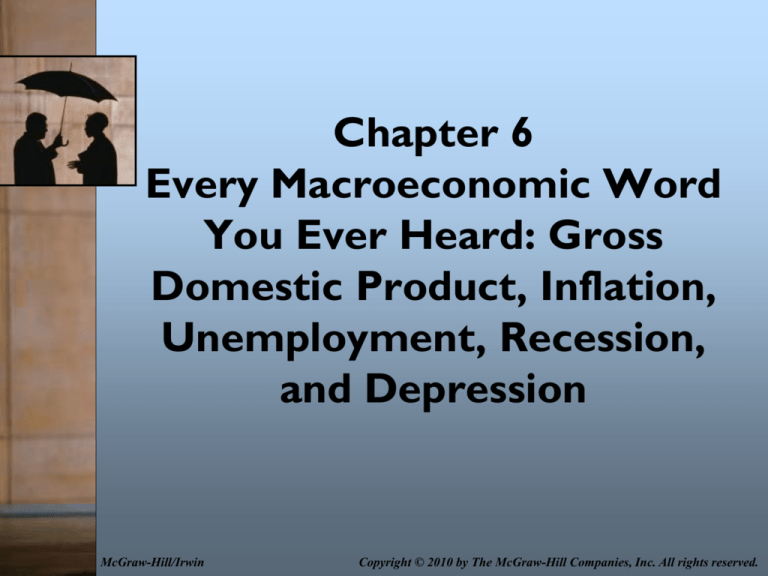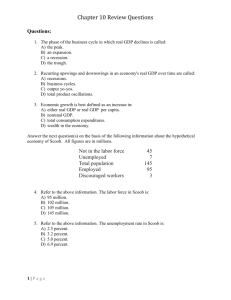
Chapter 6
Every Macroeconomic Word
You Ever Heard: Gross
Domestic Product, Inflation,
Unemployment, Recession,
and Depression
McGraw-Hill/Irwin
Copyright © 2010 by The McGraw-Hill Companies, Inc. All rights reserved.
Chapter Outline
• Measuring the Economy
• Real Gross Domestic Product and
Why it is Not Synonymous with Social
Welfare
• Measuring and Describing
Unemployment
• Business Cycles
6-2
You Are Here
6-3
Microeconomics vs. Macroeconomics
• Microeconomics: that part of the
discipline of economics that deals
with individual markets and firms
• Macroeconomics: that part of the
discipline of economics that deals
with the economy as a whole
6-4
Gross Domestic Product
• Gross Domestic Product: the dollar
value of all of the goods and services
produced for final sale in the United
States in a year
– “Final Sale” avoids double counting of
intermediate production
– “Sale” implies exclusively market activities
– “produced..in the United States” implies
that Hondas produced in the US count but
Fords produced in Mexico do not.
6-5
Measuring Prices
• Market Basket: what average people buy
and in what quantities they buy it
• Base Year: year in which the market
basket is established and year to which
all other prices are compared
• Price of the Market Basket in the Base
Year: (PBYMB) national average of the
total cost of the market basket for the
first month in the first year.
6-6
Price Index
• Price Index: a device that centers the
price of the market basket around 100
• Consumer Price Index: the price index
based on what average consumers buy
CPI in 2008
Price of the Market Basket in 2008
x100
Price of the Market Basket in the Base Year of 1998
6-7
Measuring Inflation
• Inflation Rate: the percentage increase
in the consumer price index
Inflation during 2008
CPI on January 1, 2009 CPI on January 1, 2008
x 100%
CPI on January 1, 2008
6-8
Problems Measuring Inflation
• Changes in the Market Basket occur
every two years which is too
infrequent for some goods (like
consumer electronics).
• The treatment of improvements in
the quality of goods is inadequate.
• People change the places they buy
frequently.
• No accounting for substitutions
6-9
Bureau of Labor Statistics
Adjustments
• The BLS is dealing with
– Consumer electronics issues by pricing an
index of quality rather than a specific item.
– The “infrequent updates problem” by
moving to a two-year chain-based index, a
price index that is based on an biannually
adjusted market basket.
• The CPI still overstates the cost-of-living
by 0.8%.
6-10
Alternative Measures of Inflation
• Core CPI: The consumer price index that has had
the impact of food and energy costs removed.
• Personal Consumption Expenditures deflator:
A chain-based price index that adjusts for the
substitution problem.
• Core PCE: The Personal Consumption
Expenditures deflator that has had the impact of
food and energy costs removed.
• Producer Price Index: A price index based on what
firms buy.
6-11
Alternative Measures of Inflation
6-12
The CPI and Inflation in Selected
Year Base Years (1982-1984)
Year
1930
1950
1970
1990
1995
2000
2005
2006
2007
2008
CPI
Inflation Rate
16.1
25.0
39.8
133.8
153.5
174.0
196.8
201.8
210.0
210.2
6.1
2.5
3.4
3.4
2.5
4.1
0.1
6-13
Cost of Living Adjustments
• Cost of Living Adjustment or
COLA: a device that compensates
people for the fact that inflation
makes the spending power of their
income less
6-14
Inflation’s Winners and Losers
• Losers
– People on fixed incomes
– Lenders
• Winners
– Borrowers
6-15
Interest and Expected Inflation
• If inflation exceeds expectations
then borrowers win and lenders
lose
• If inflation is less expectations then
borrowers lose and lenders win
6-16
Real Gross Domestic Product
• Real Gross Domestic Product: an
inflation adjusted measure of GDP
• GDP Deflator: the price index used to
adjust GDP for inflation, including all
goods rather than a market basket
RGDP=
GDP
GDP Deflator
*100
6-17
Post WWII RGDP 2000 in billions
6-18
Problems With RGDP
• GDP only counts market sales so it
ignores home production.
• GDP ignores the value of leisure
• GDP ignores the composition of output
• GDP should be a per capita measure
• GDP ignores environmental measures
• GDP ignores the “underground
economy”
6-19
Measuring Unemployment
• Work Force: all those non-military
personnel who are over 16 and are
employed or are unemployed and
actively seeking employment
• Unemployment Rate: the percentage
of people in the work force who do
not have jobs and are actively seeking
them
6-20
Unemployment Rate Formula
• # of unemployed X 100
Total Labor Force
6-21
Problems Measuring
Unemployment
• Underemployed : the state of working
significantly below skill level or working
fewer hours than desired
• Discouraged worker effect: when bad news
induces people to stop looking for work
causing the unemployment rate to fall
• Encouraged worker effect: when good
news induces people to start looking for
work causing the unemployment rate to
rise (until they succeed in finding work)
6-22
Annual Unemployment Rates
6-23
Types of Unemployment
• Cyclically Unemployed: people lose their jobs
because of a temporary downturn in the
economy
• Seasonally Unemployed: (a subset of the
cyclically unemployed) people who lose their
jobs predictably every year at the same time
• Structurally Unemployed : people who lose
their jobs because of a change in the economy
that makes their particular skill obsolete
• Frictionally Unemployed: people who are
unemployed for a short time in the transition to
an equal or better job
6-24
The Business Cycle
• Business Cycle: regular pattern of ups and downs
in the economy
• Trough: the lowest point in the business cycle
• Recovery: the part of the growth period of the
business cycle from the trough to the previous
peak
• Expansion: the part of the growth period of the
business cycle from the previous peak to the new
peak
• Peak: the highest point in the business cycle
• Recession: the declining period of at least two
consecutive quarters in the business cycle
6-25
The Business Cycle
Peak
RGDP
Peak
Trough
time
6-26
The Business Cycle 1981 to 2009
6-27
If Inflation is Bad How can Deflation
be Worse?
With deflation
• People delay buying big ticket items when they are
certain it will be cheaper if they are patient.
• If they delay buying
– then demand for those goods will fall.
– firms will cut costs by cutting wages and benefits, or by
laying people off.
– when profits decline, the value of stocks decline. With
less wealth, stockholders spend less on consumer
goods.
– housing prices may decline. Purchases that are made
using home equity decline.
6-28
Depression
• Depression: There is no generally
accepted standard but most are
characterized by a severe recession
that results in a financial panic and
bank closures, unemployment rates
exceeding 20%, prolonged
retrenchment in RGDP on the
magnitude of ten percent or more,
and significant deflation.
6-29
Kick It Up A Notch:
RGDP Accounting
6-30
Alternative Approaches to GDP
Calculations
Expenditures Approach
Amount
Income Approach
Amount
Personal Consumption
$9,710.2
Employee
Compensation
$7,819.4
Gross Private Investment
$2,130.4
All Profits
$3,386.0
Government Consumption
and Investment
Expenditures
$2,674.8
Net Property Income
Net Exports
Gross Domestic Product
-$707.8
$13,807.6
$109.4
Indirect Business Taxes
$1,105.5
Depreciation
$1,720.5
Minus Income Earned
Abroad
-$102.4
Statistical Discrepancy
$81.4
Gross Domestic
Product
$13,807.6
6-31








